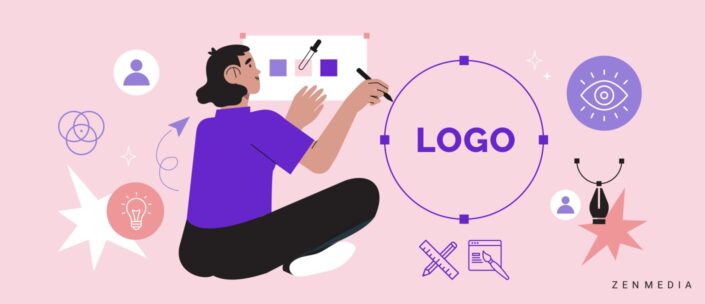A great B2B brand logo can do wonders for your brand identity and recognition. It’s the Batman to your Gotham City, the swoosh to your “Just do it,” or the eye-catching arrangement of primary colors that makes all Google products distinctly recognizable.
When it comes to B2B branding, your logo plays a crucial role in creating brand identity and recognition. A well-designed logo is an essential element that can set your brand apart from the competition, and a poorly designed one can be a hindrance.

Your logo is the face of your brand. It’s the first thing people see when they encounter your business. Think of your logo as a visual representation of your brand’s identity, values, and personality. It also leads your marketing efforts. A great logo is instantly recognizable to your audience. When they see your logo, or an icon branded to match or align with your logo, they should immediately think of your brand. If your logo and their perception of your brand are strong, seeing your logo will evoke positive emotions.
On the other hand, a bad logo can be “bad” for a number of reasons, and the fallout can be dire. Here’s what you should avoid:
- A logo that is detached from the voice, vibe, and mission of your brand may come across as confusing to your audience or simply not memorable.
- A poorly designed logo can make your brand appear unprofessional, cheap, or outdated.
- A logo that’s too generic or lacks relevance to your brand may be forgettable to your audience, or they may confuse your brand with another.
- A logo that’s too dramatic or complicated may be distracting or simply unappealing.
In the B2B world, where trust and credibility are essential to building relationships with clients and prospective customers, it’s necessary to have a strong brand identity. That’s why it’s crucial to ensure that your B2B logo effectively represents your brand and creates a positive first impression.
How To Come Up With a Company Logo
A good logo goes beyond visual elements and tells your brand story in a memorable, succinct way. To maximize impact, follow the steps below throughout your B2B logo design journey.
Understand Your Brand Values and Goals
Before you start brainstorming logo ideas, it’s important to have a clear understanding of your brand’s values, goals, and personality. What do you want your brand to communicate to your target audience? What makes your brand unique and different from your competitors? What do you want your brand to be known for? What values does your brand represent? Who is your target audience, and what message do you want to convey to them through your logo?
For example, if your B2B company is focused on sustainability and environmental responsibility, you may want to incorporate elements of nature or earthy tones into your logo design. If your brand is focused on innovation and cutting-edge technology, you may want to use sleek, modern fonts and geometric shapes in your design.

By having a clear understanding of your brand’s values and goals, you can ensure that your logo accurately represents your brand and is in alignment with your mission.
Research Your Competition
Once you have a clear understanding of your brand values and goals, it’s important to research your competition to see what they’re doing with their branding and logo design. This can help you identify what’s working and what’s not, and it can give you some inspiration for your own logo design.
To start your research, take a look at your competitors’ logos and analyze them. What do you like and dislike about their designs? Are there any common themes or elements that you can identify? Are there any opportunities for you to differentiate your brand from your competitors through your logo design?
It’s important to remember that while you can draw inspiration from your competitors’ logos, you should never copy their designs. Your logo should be unique to ensure your brand stands out from others in your industry.
By researching your competition, you can better understand what’s currently popular and influential in your industry. Use this knowledge to create a unique and effective logo that authentically represents your brand.
Brainstorm and Sketch Out Ideas
You may find the direction you want to pursue after researching competitors and determining your brand values and goals. But before you go all in on a single concept, remember that art is subjective. How you perceive a symbol, color, or font may be different than how others perceive those same elements.
It’s always a good idea to get multiple opinions and insights before you lock in a logo design. Start by gathering your creative team. These should be people who understand your brand and can provide valuable input. This group could include members of your marketing team, graphic designers, and even stakeholders from within your company. Schedule several brainstorming sessions, as these great opportunities for team-building and collaboration can lead to some truly creative and innovative ideas.
When sketching out your concepts, don’t worry about making them perfect. The goal is to simply collect ideas in a visual form so that you can discuss them and ponder how they might be perceived by your audience. Sketch out multiple variations of your ideas, and don’t be afraid to experiment with different shapes, colors, and fonts.
Once you’ve narrowed down your graphic elements, you can start to refine them into more polished sketches or digital designs.

Work With a Professional Designer
While it’s possible to create a logo on your own, working with a professional logo designer will help ensure that your logo uses proven aesthetic and branding strategies that are attractive, grab attention, represent the right tone and messaging, and appeal to your target audience.
When selecting a logo designer, it’s important to choose someone who has experience working with B2B brands. Strong designers and the marketing and PR agencies that employ them should have portfolios that showcase their design skills and creativity. Take the time to review their work and talk through your design to make sure you have the right partner.
Once you’ve selected a designer or B2B marketing agency, it’s important to clearly communicate your company values and goals. At the same time, be sure to provide your designer or agency with any sketches or ideas you may have already developed—even rough doodles. This will help the designer understand your vision and create an asset that accurately represents your brand.
Working with a professional designer can be an investment, but your logo will be everywhere—hopefully for many years—so it’s an endeavor that will pay off in the long run.
Characteristics of a Good B2B Brand Logo
A great B2B brand logo should be simple, memorable, and versatile. When designing your logo, keep these three characteristics in mind to ensure that your logo accurately represents your brand and appeals to your target audience.
Simplicity and Clarity
One of the most important characteristics of a good B2B logo is simplicity and clarity. Your logo should be easy to understand and recognize at a glance—especially at small sizes. A simple and clear design is often more dynamic and easier to place than a highly detailed and complex design.
To achieve simplicity and clarity, consider using a simple icon or symbol and limiting the number of colors and fonts used in your design. This will help ensure that your logo is easy to comprehend and that it works well across different media and platforms.

Memorable and Recognizable
Your logo should be distinctive and unique. Many of the best logos from successful brands incorporate visual symbols or icons that are easily recognizable even without the full brand name. Consider incorporating unique shapes or design elements, or try bold colors that stand out. If your brand name includes something that is easy to visualize, consider leaning into it like the oil company Shell did with their famous seashell logo, or Apple’s famous bitten-into-apple logo that aligned with their line of Macintosh products named after the fruit.

Versatility and Scalability
Your logo should be designed in a way that allows it to be used across different media and platforms, from your website to your business cards to your social media profiles.

A professional designer will design your logo in vector format, allowing for easy resizing and editing without losing quality. Remember to consider how your logo will look in black and white or when printed on different backgrounds. You never know when you’ll need a logo with a transparent background or one in a different color. A good designer will ensure you can easily make these adjustments when necessary.
Tips for Improving Your B2B Brand Logo
Creating a great B2B logo is a continuous process, and it’s important to regularly evaluate and improve your logo design to ensure it remains relevant and effective. This doesn’t mean changing your logo every quarter or even every year—that would be costly and make it difficult to connect your brand with your logo. However, it is good practice to check your logo every few years to determine if you need to make any adjustments. Start by reading our advice below.
Get Feedback from Customers and Stakeholders
One of the best ways to improve your logo is to get feedback from your customers and stakeholders. This can help you identify areas for improvement and gain valuable insights into how your brand is perceived.
Consider conducting surveys or focus groups to gather feedback on your logo design. Ask questions about what customers like and dislike about your logo, and whether they find it memorable and recognizable. Use this feedback to guide your logo redesign efforts and make improvements that resonate with your target market.
Update or Modernize an Existing Logo
If you already have a logo, consider updating or modernizing it to keep it fresh and relevant. This can involve making minor tweaks to the design or updating the color palette to reflect current design trends.
When updating your logo, be sure to retain the core elements that make it recognizable and memorable. This can include the color scheme, typography, or imagery. The goal is to modernize the design while still retaining the brand identity and recognition that customers have come to associate with your brand.

Consider Completely Rebranding if Necessary
In some cases, you may find that you simply need a new logo. If you find that your current logo isn’t working, you should audit the entire visual identity of your brand to determine whether your brand’s color scheme, patterns, font, and so on need to be updated in other places beyond the logo itself.

Rebranding should be driven by a clear business strategy and a deep understanding of your target audience and market position. As with all branding efforts, this can be a significant undertaking, but it can also be a valuable opportunity to refresh your brand and position it for long-term success.
A great B2B brand logo is essential for creating a strong brand identity and B2B brand awareness in the market. By understanding the characteristics of a good logo and the signs of a bad one, you can ensure that your logo is effective in representing your brand.
Whether it’s updating an existing logo or starting from scratch, working with marketing and design professionals can make all the difference when creating a memorable visual identifier that resonates with your audience.
Related Reading: Three Reasons Why Lack of Brand Awareness Hurts B2Bs More Than Negative Perceptions
Want to rework your logo? Reach out.






